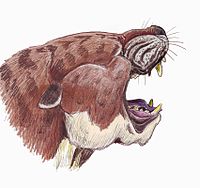Creodont
| Creodonta Temporal range: Early Paleocene to Late Miocene, 63.3–11.1 Ma |
|
|---|---|
 |
|
| Sarkastodon | |
| Scientific classification | |
| Kingdom: | Animalia |
| Phylum: | Chordata |
| Class: | Mammalia |
| (unranked): | Ferae |
| Order: |
†Creodonta (Cope, 1875) |
| Families | |
†Hyaenodontidae
†Oxyaenidae
†Limnocyonidae (?)
Creodonta is an extinct, potentially polyphyleticorder of carnivorous mammals that lived from the Paleocene to the Miocene epochs. Because they both possess carnassial teeth, creodonts and carnivorans were once thought to have shared a common ancestor, but given that different teeth are involved in making up the carnassials (both between creodonts and carnivorans and between the main groups of creodonts), this appears to be a case of evolutionary convergence. Carnassials are also known in other mammal clades, such as in the extinct bat Necromantis.
Two distinct families were historically thought to compose the order: Oxyaenidae and Hyaenodontidae. They may both represent separate orders of fossil mammals related to carnivoramorphs or are descended from more basal taxa.
Creodonts had an extensive range, both geographically and temporally. They are known from the late Paleocene through the late Oligocene in North America, the early Eocene through late Oligocene in Europe, from the early Eocene through late Miocene in Asia, and from the Paleocene to the late Miocene in Africa.
Creodonts were the first large, obviously carnivorous mammals with the radiation of the oxyaenids in the late Paleocene. During the Paleogene, they were the most abundant form of terrestrial carnivore in the Old World. In Oligocene Africa, they were the dominant predatory group. They competed with the Mesonychids and the Entelodonts and ultimately outlasted them by the start of the Oligocene and by the middle of the Miocene respectively, but lost ground to the carnivorans. The last genus became extinct 11.1 million years ago, and carnivorans now occupy their ecological niches.
...
Wikipedia
